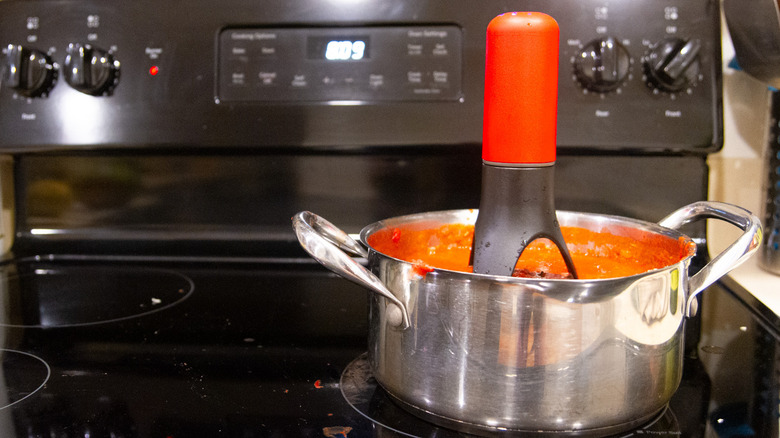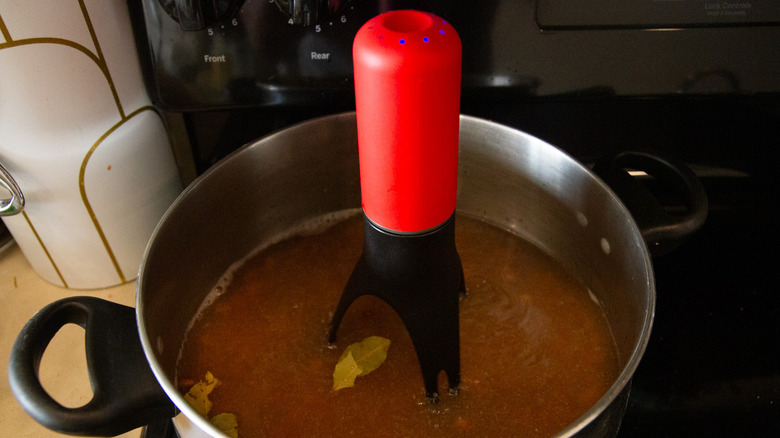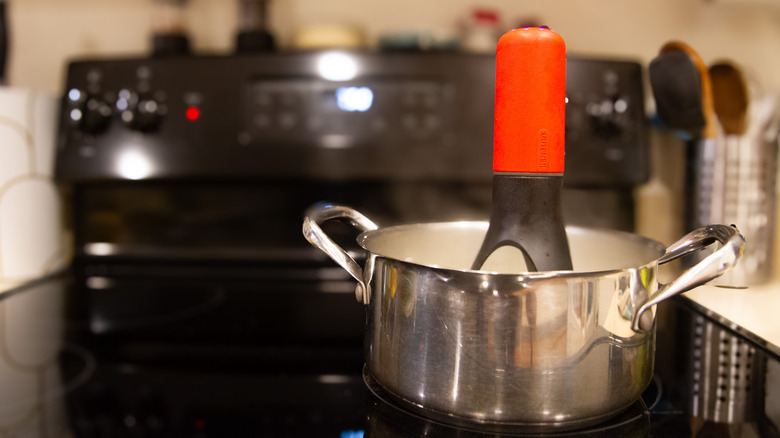Do Automatic Pan Stirrers Really Work? We Tried One To Find Out
Domestic life today sounds like something out of "The Jetsons": We've got robot vacuums, parking-assist cars, voice-activated assistants, and now, automatic pan stirrers. We really do live in the future. As with any futuristic technology, some newfangled kitchen gadgets are essential, and some aren't. Here, I test one popular model of automatic pan stirrer, the üutensil Stirr, to see if it works, and whether or not it's worth purchasing.
I put the pan stirrer to the test in several different pans and in a variety of everyday cooking situations, from sauteing vegetables to slow-simmering tomato sauce, and boiling beans– two dishes I've sadly burned more than once. I have a tendency to multitask in the kitchen and can easily get distracted from any recipe that has to cook for more than 30 minutes, so I'm exactly the sort of person an automatic stirrer is designed for. Here I'll examine how it performed in my home kitchen from start to finish.
Some recommendations are based on firsthand impressions of promotional materials and products provided by the manufacturer.
What is an automatic pan stirrer?
I tested the Stirr automatic pan stirrer from üutensil, a U.K.-based company founded in 2009 which produces a line of reimagined kitchen tools and utensils. Like other automatic pan stirrers, the Stirr is a hands-free electronic cooking tool designed to sit in a pot of food as it's cooking over heat and stir the contents of the pot without the need for human interference. Its three legs spin in place and periodically move around the pan, to agitate the food and therefore stir it.
The Stirr comes with a charger, charger cord, and the unit itself, which is packaged in two parts: a chargeable base with a brightly-colored, soft, and grippy handle, and a three-pronged leg attachment made of black heat-resistant plastic that's safe up to 248 degrees Fahrenheit. It's widely available at retailers nationwide from Amazon to Walmart where it sells for $36.95, or you can purchase it directly from üutensil for $27 plus shipping.
How to use one
Before you can use the Stirr, you must charge up the base using the included charger. It takes about two hours to charge initially. Once charged, assembly couldn't be easier; you just insert the legs onto the base and you're ready to go. Place the Stirr unit into your pot of food, making sure that the electronic base is not submerged in liquid. Press the button on the top of the base to turn it on and select the speed. One press produces the slowest stir setting. Press the button a second time for medium speed, and a third time for the fastest stirring speed. Holding the button down for two seconds allows you to set a one, two, or 10-minute timer, indicated by red LED lights. Without a timer, the unit will run until you turn it off or it exhausts its charge (just over two hours during my test).
Once you've selected your speed and set your Stirr to work, there's nothing else to do. The instructions clearly state it's not to be left unattended, so you still need to monitor your food and be aware of what's happening in the kitchen. But, it does relieve you from the constant attention many dishes need.
Once you're done cooking, the legs can be removed and washed in the dishwasher or by hand using regular dish soap. The base can be wiped clean using a damp cloth but is not dishwasher-safe and cannot be submerged in water.
Sauteing with an automatic pan stirrer
My first test of the Stirr was sauteing diced onions for tomato sauce. I loaded up my stainless steel pot with a layer of chopped onions about three inches deep and put the Stirr to work. It did its best but struggled to move around the crowded pan and to unstick onions once they adhered to the bottom of the pan. I tried again with mushrooms and a less crowded pot, but it still struggled to dislodge pieces that had become stuck to the pan as it worked its way around. It just doesn't have enough momentum or downward force to scrape them up. However, when I repeated the saute test using a nonstick pan, the Stirr performed much better. The difference was tremendous. The manufacturer does specify that it works best in a non-stick pan, and the brand is not kidding. It also suggests an ideal pan size of seven to 11 inches, but I found pan size far less crucial.
Once I switched over to using a nonstick pan, the Stirr worked like a charm. At times, it appears that it's just going in a circle in the center, so it's hard to trust it. But over time, it indeed does make its way around the pan. You just have to have a little faith and let it do its thing — in a nonstick pan.
Slow cooking with an automatic pan stirrer
Next, I moved on to the slow cooking test. I moved the vegetables I'd sauteed into a heavy-bottom stainless steel pot with 48 ounces of crushed tomatoes, put it over low heat to simmer, and hoped that my almost complete lack of nonstick cookware wasn't going to cause Stirr to struggle.
It struggled. This time I don't think it was down to my cookware, but the thickness of the sauce. I prefer a chunky tomato sauce, but in the interests of science, I puréed the tomatoes into a smoother texture and tried again. With that adjustment, the Stirr chug-a-lugged around the pot like a little robot champion. I was still worried the sauce was going to stick and burn, but to give it a fair test, I decided to leave the Stirr alone, unaided, for 40 minutes. I was pleasantly surprised when my sauce did not burn but simply bubbled away on the stovetop with the Stirr's help. It didn't even struggle with the Parmesan rinds I had added.
Next, I tested it with my other culinary nemesis: boiling beans. It performed even better in stirring a pot of beans. I walked away and forgot about them for about 45 minutes, but when I came back, nothing had stuck, and nothing was burned. Amazing! Around this time, the unit's battery needed recharging, after about two hours of on-and-off use over 24 hours.
Pros
The Stirr device is easy to assemble, straightforward to use, and, since it has minimal buttons and settings, it's not over complicated to get started using it. It works very well on certain types of food with almost no effort. It comes with a charging base and cord, so there's no reordering batteries or creating excess waste with a disposable power source. The base and charger really do look great on the counter, it has a sort of sleek and cheerful style and comes in several colors to match your decor.
Despite looking flexible and delicate, the legs hold up better than you'd expect against hot foods and pans. The Stirr is fairly easy to clean because it comes apart, has simple construction with few external moving parts, and the legs are dishwasher safe. Stirr acts as a second set of hands, allowing you to multitask and chop, prep, or clean while food is cooking. And while the instructions clearly say not to leave Stirr unattended, in the real world many of us will get distracted while cooking and wander off (a common cooking mistake), but Stirr stays on the job to prevent minor cooking disasters, which are all pros in my book.
Cons
Now for the cons. Particularly with thicker liquids such as tomato sauce, using Stirr causes more splatter. This is partly because you can't put a lid on with Stirr extending out of the top of the pan, and also because the gentle stirring leaves bigger bubbles of air escaping from the liquid. On the plus side, you won't be hit and burned by any of these errant splatters since the automatic stirrer is stirring for you — but it does make stove cleanup harder. Intricate openings on the legs can collect food particles, making those areas harder to clean. For example, after Stirr agitated the semi-melted Parmesan rinds in my tomato sauce, the melted cheese was difficult to remove from the legs.
Pulling it out of the pot gets messy unless you turn it off first, which means cycling through the higher speeds and sometimes the legs come off as you're trying to extract it. I'm sure there's a knack to this, but I haven't mastered it yet. It Works better on nonstick cookware: For sauteing, nonstick cookware is practically mandatory when using Stirr. It also takes a little trial and error to determine the best speed setting, which foods will and won't work, and to relax and actually trust that Stirr will do the job it's created to do.
What does it work best for?
Stirr works best on high-moisture foods that cook slowly over low heat, like beans, smooth sauces, and soups. The difference in performance is particularly pronounced with sauteing. Think recipes that include the phrase "stirring occasionally." In addition to working better on these types of foods, it's also more useful in these kinds of recipes for two reasons. First, it takes longer for slow simmered foods to stick or burn, so there's less risk in leaving the stirring to a machine. Second, using an automatic stirrer for long slow cooking provides the greatest time and labor savings. The convenience of not having to tend a pot of beans for hours is much more of a luxury than escaping five or 10 minutes of sauteing.
It will work for sauteed foods, but it certainly performs better in nonstick cookware. I tested the same food items in stainless steel and nonstick and it works significantly better in nonstick pans.
Does it work, and is it worth buying?
The verdict is: It works. It won't mean you'll never stir a pot by hand again, but for a great many foods, an automatic stirrer will free you up to focus on other kitchen tasks like chopping or cleaning. It will salvage forgotten pots of beans (to a point) and release you from the tyranny of "stirring occasionally" for hours on end. It absolutely seems like the type of device you'd use more and more the longer you have it, until it gradually becomes indispensable. It's worth buying if you frequently make slow-simmered foods, particularly if you're prone to distraction or often find yourself multitasking.
It will be even more useful for anyone who primarily uses nonstick cookware. At less than $40, it's not exorbitantly priced, so if you're curious, I say you should give it a try. The bottom line is it's easy, fun, and handy. I'd get one just to stop burning my beans.








